Contents
- Tip 1: Avoid plastic when shopping
- Tip 2: Pack your provisions with intention
- Tip 3: Use reusable containers
- Tip 4: Take rubbish home with you - even organic waste!
- Tip 5: Stay local and keep it real!
- Tip 6: Po Time!
- Tip 7: Dog Time!
- Tipp 8: Practical for multi-day tours
- Tipp 9: Avoid hazardous waste
- Tipp 10: Avoid microplastics on arrival and departure
- Biodegradation time: What needs how long?
- Zammrama: Worthwhile waste collection campaigns in the mountains
The latest motto of the Zugspitz Region is “Be prudent, nature-friendly and passionate in the mountains!” In 2021, the Tölzer Land in Bavaria invites people to move considerately in and through nature with the campaign “Nature conservation begins with you”. Two examples show how important it is for more and more tourism regions to establish responsibility for protecting and preserving the environment and nature. In the 1960s, “the proper mountaineer” was still supposed to “bury his rubbish” according to the instructions on environmental awareness. He breaks glass into tiny shards. And tin cans he first kicks flat and then hides them under stones!” It’s a good thing that since the 70s the number one rule has been: rubbish has no place in nature. Leave every area as you found it – or better: What you bring to the top comes back down with you.
What goes up must come down!
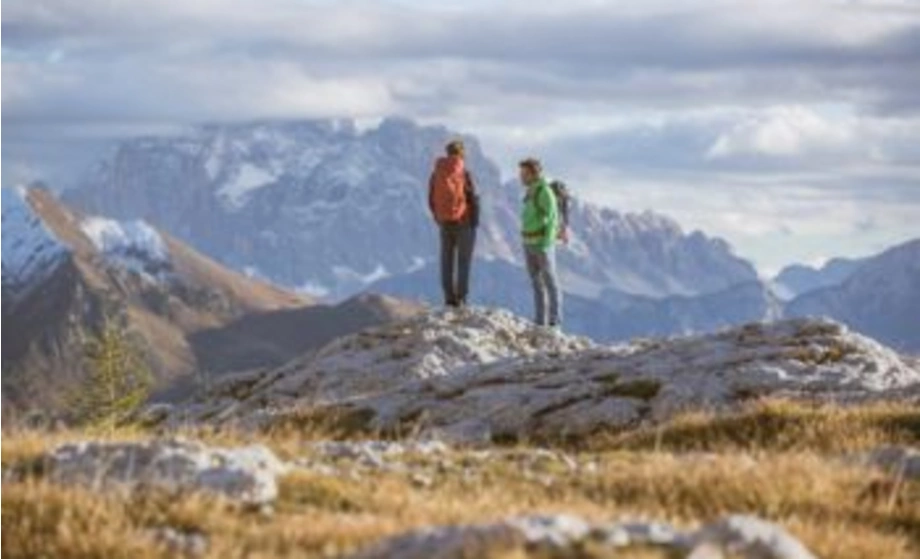
We love the mountains – so it should go without saying that we try to keep them clean and litter-free.
But the fact is, whether in the park next door, on the way to the alpine hut or at Everest Base Camp, more and more hikers, newcomers to outdoor and mountain sports, and excursion guests view the mountains as an amusement park. They disregard rules of conduct, are careless, often also ignorant and thus destroy sensitive ecosystems. But it is not about pointing the finger at others. If you want to treat your environment with respect, you start with yourself. Here are our ten best tips for reducing your waste when participating in mountain sports.
Tip 1: Avoid plastic when shopping
Plastic drains valuable resources and is an environmental killer when it comes to waste. Therefore, conscious consumers avoid plastic and packaging when shopping. Avoid plastic by shopping in stores that offer unpackaged items, buy vegetables/fruit in bulk, choose glass instead of plastic and film packaging and reusable packaging or storage containers instead of disposable packaging.
Tip 2: Pack your provisions with intention
Instead of packing bread, fruit, vegetables and snacks in aluminium foil or cling film, beeswax wipes (also available on a roll), cloth bags and snack bags made of paper/bread paper are good options. The latter has a better ecological footprint than plastic bags only after being used at least three times. If you swear by fresh food bags, you can also get reusable ones: they are washable, used several times, or even compostable. For example, numerous suppliers use bioplastics, such as those without microplastics, based on potato starch. If you like the practical Ziploc bags, you should use them several times, but cheap ones often break faster. None of this should end up in nature or hut rubbish bins after use.
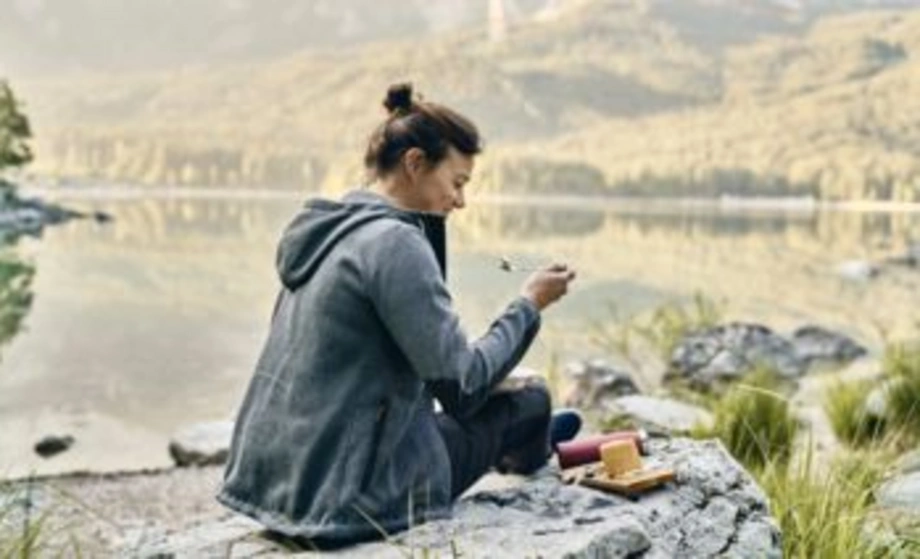
Reusable containers such as drinking bottles and lunch boxes transport your food safely up the mountain and do not produce unnecessary waste.
Tip 3: Use reusable containers
Ideal if you prepare your hike at home so that you don’t take any packaging with you. The single-material polypropylene (PP) packaging of the chocolate bar, the bag with the snacks/nuts, etc., disappears into the yellow bag for recycling. They are so tear-resistant and coated that it takes several decades to decompose into microplastic in nature. Plastic lunch boxes are acceptable if you repeatedly use them. And their contents do not need to be specially wrapped in cling film. Snack boxes made of stainless steel, aluminium, bamboo, various wood and recycled materials, some of which are also compostable, are even available with unique “dividers” so that nothing gets mixed up inside. Reusable drinking cups, insulated bottles made of aluminium, steel, glass and BPA-free reusable containers are practical for on the go.
Tip 4: Take rubbish home with you – even organic waste!
And of course, packaging for trekking meals or chocolate bars and leftover bread and fruit peels end up in the dirtbag after use and later in the (residual) waste. If they are not organic, the peels of bananas, kiwis, and the like have pollutants that take a long time to decompose, pollute the soil and the environment, and are inedible or even toxic for most animals. Adhesive labels on them ensure that microplastics accumulate in the ground, and it takes several human lifetimes before they are no longer detectable. Like any plastic waste, they disturb the balance of the soil around the organic substances it emits and absorbs. After all, a PET bottle takes up to 1,000 years to decompose! But then only into invisible microplastics, which increasingly enter the human food chain.
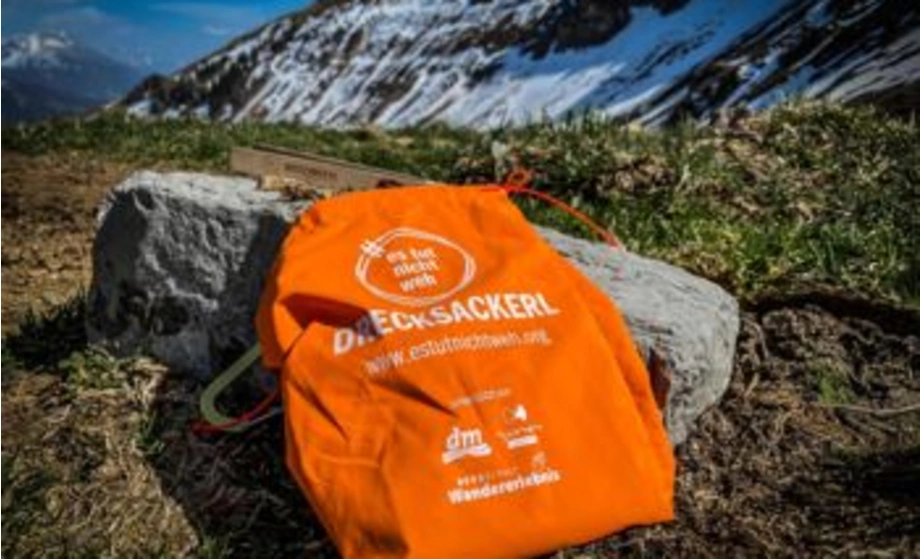
With a “Drecksackl” or a plastic bag that you bring yourself, you can transport the rubbish from your snack or toilet trip back down to the valley without any ugly spills.
Tip 5: Stay local and keep it real!
Those who support local providers, stay in managed alpine huts, with alpine dairymen or in mountain inns, do not only enjoy homemade and regional meals of high quality. They also help to avoid waste. And of course: the rubbish you bring with you goes back down into the valley. Unless the owners expressly allow a small amount to be left behind.
Tip 6: Po Time!
If you leave your business behind a tree or rock in nature, you produce the most unacceptable waste: Paper tissues take over a year to decompose. Wet wipes take even longer; thin, single-layer toilet paper wins the race. Better still: use toilets supplied by mountain inns and huts. If they are closed, and your bladder is still bursting, make sure to bury your urine a reasonable distance away from the path and cover it with leaves. It is even better if leftovers and hygiene waste are packed in a sealable rubbish bag, taken along and disposed of later. Responsible hikers rely on pee rags: a reusable piece of fabric that functions like a bandana, a small trekking towel or similar and washed out as soon as possible and left to dry on the outside of the backpack until ready for subsequent use.
Tip 7: Dog Time!
Dog excrement must be removed from pastures, alpine meadows and the like when hiking in the mountains. Dog excrement takes about 46 days to decompose by 50%. The heat generated during decomposition is insufficient to kill all the faeces parasites, pathogens, and bacteria. What survives can become deadly for forest or alpine animals and dangerous for us humans. By the way, even organic poop bags, such as those made from maise, sugar beets or potatoes, do not degrade completely – even though they are advertised as such. Therefore, no matter how correct, all dog excrement bags have no place in nature but only in the residual waste.
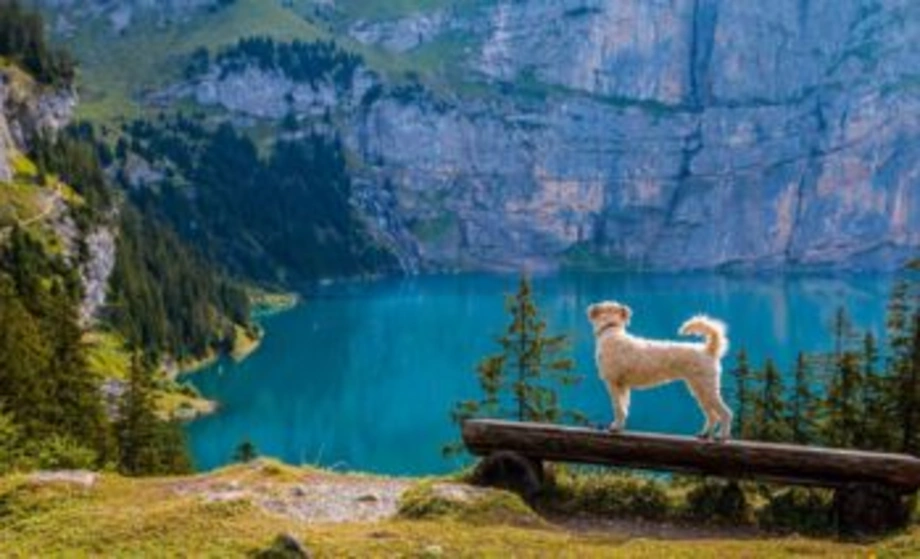
You should also take your dog’s droppings back down to the valley and dispose of them there in the residual waste. Dog excrement can be dangerous for alpine animals.
Tipp 8: Practical for multi-day tours
Biodegradable cosmetics such as toothbrush tabs, powder for hair and body that foams up with water to become soap, shampoos and solid soaps reduce waste and weight. Concentrates, refills and paper-wrapped cosmetics are also good ideas to reduce plastic waste. Travel detergent from a tube? Replace it with grated curd soap. By the way: no matter how biologically correct everything is, when using soap & co, keep at least 50 metres away from the nearest water source. After all, the goal of humans is to have a “minimum impact” – in other words, to leave as few traces as possible! Suppose you use a simple, recyclable drawstring bag made of light fabric, old clothing, waterproof materials or your remaining stock of plastic bags. In that case, you can transport used toilet paper/tissues, (washable) pantyliners/pads – in other words, everything that belongs in the residual waste or is recycled – pack in a scent-proof way, and you won’t get your backpack dirty.
Tipp 9: Avoid hazardous waste
Due to pandemics, FFP2 disposable masks are now very often found in nature. Their hard-to-degrade synthetic materials take over 400 years to decompose! Cigarette butts take almost as long, severely endangering the living soil, its essential biodiversity of organisms and microorganisms. Just one butt brings toxic arsenic, lead, copper, chromium, cadmium, formaldehyde, polycyclic aromatic hydrocarbons and the highly poisonous alkaloid nicotine into the soil – a total mix of up to 4,000 harmful substances. The filter’s non-degradable plastic cellulose acetate also produces microplastics: 40 to 60 litres of water are contaminated around the butt of the cigarette alone. And another thing: even a tin can kill grazing animals.
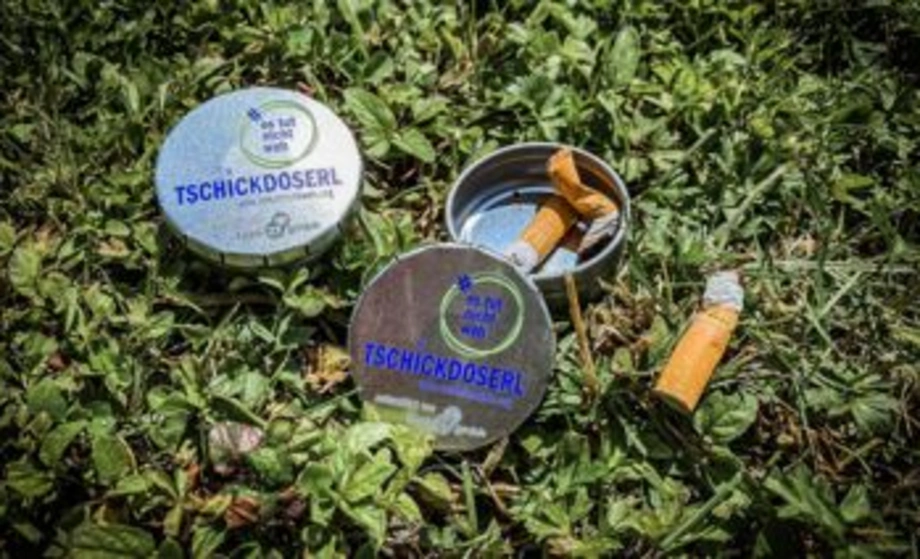
Cigarette butts carry toxic substances into the soil and take up to 400 years to decompose completely. It is better to put them in a can and take them home to the residual waste.
Tipp 10: Avoid microplastics on arrival and departure
Minimum Impact also applies to the journey to and from the hiking area. Did you know that, according to the Fraunhofer Institute for Environmental, Safety and Energy Technology, the most significant proportion of microplastics in the environment worldwide comes from tyre and road abrasion? Therefore, a “litter-free hike” also includes planning an environmentally friendly means of transport such as a bus or train. Or, if there is no other way: use carpools!
Biodegradation time: What needs how long?
This is how long it takes to decompose in nature – depending on the environmental conditions on-site such as precipitation, heat and cold, wind and friction, soil properties and microorganisms. Why does decay take longer in the mountains? Fewer microorganisms can promote rot because of the altitude, the lack of a humus layer, and low temperatures.
The most important information in brief:
It takes 1 to 3 years for a banana peel to rot in nature.
Tempos & Co need 1 to 5 years to decompose.
It takes approx—five years for chewing gum to decompose.
It takes 10 to 20 years for a thin plastic bag to decompose.
It takes 25 years for aluminium foil to be degraded entirely in nature.
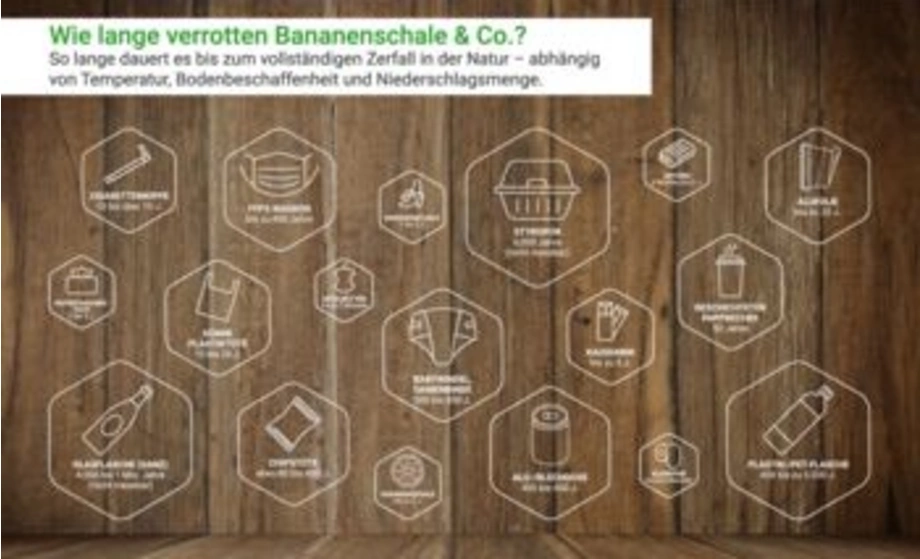
Banana peel, glass bottle or FFP2 mask: How long does this waste take to decompose completely? | Source: Beate Hitzler
Zammrama: Worthwhile waste collection campaigns in the mountains
As a dog owner, I am outside every day, equipped with bags for the dog’s waste. On almost every walk, I pick up an additional ten pieces of rubbish – often more. Because obviously, it works: where there is no litter, less litter is thrown away. Besides, hope dies last that people will change when they see that it’s easy to pick up rubbish. I have already infected many people. Even children are eager to do it, are happy to have a sense of achievement – they are learning for their future. Even if you only collect “one a day” – flora and fauna benefit and have already done something good for nature. We have compiled a list of the most important “official” waste collection campaigns for you here:
- Every year, the DAV organises #hikeuppickup waste collection campaigns in its managed hut and trail areas, where everyone can support the volunteer speakers. Participation is free, accommodation, meals and travel costs from Munich are covered.
- ValleyGreenUp – The Ammergau Alps Nature Park is looking for volunteers for the Hiking and Litter Picking Campaign on 11 September 2021. In cooperation with the Ziener company and the traditional association König Ludwig Lauf e.V., mountains and valleys will be cleared of unwelcome leftovers on 30 hikes. On the day of the campaign, all participants will receive a starter kit with goodies, a T-shirt, food, a hiking map, tongs and bin liners made of maize starch. On the way, the rangers of the nature park will be on hand to offer advice and support.
- Austria’s #estutnichtweh initiative acts according to an effective, simple philosophy: anyone who stumbles across rubbish along the way picks it up and takes it with them. Prominent supporters of the association include two-time world champion and freeride pro Eva Walkner and the drugstore chain dm. Starter kits for new club members are Drecksackerl, Mistzangerl and Tschickdoserl. Deuter, hyphen-sports, Edelrid, Hydro Flask, Pyua and the mountain school Wandererlebnis support the initiative.
- Plogging is a mixture of jogging and plocka upp, the Swedish word for picking up. Anyone who collects rubbish during their trail running, walking or jogging rounds and then disposes of it properly becomes a plogger. Plogging groups and events have emerged from this environmentally conscious sport, which was the brainchild of Swedish environmental activist Erik Ahlström, and more and more like-minded people and young people in Germany are taking part in this movement. Go Plogging is also available as an app.